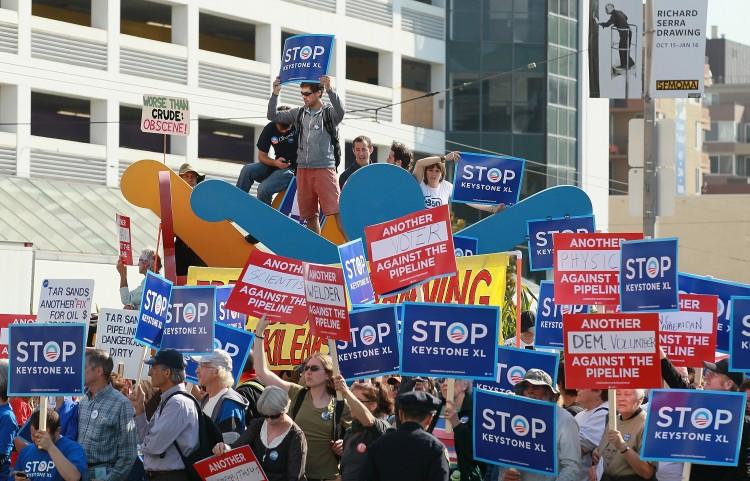The State Department’s Nov.10 announcement to postpone the planned transnational Keystone XL oil pipeline brought mixed reactions from parties of interest, revealing a complexity to the broad political, environmental, economic, and local implications that could cost—or save—Americans more than just money.
The State Department, with direction from the White House, will push approval for the project into the first quarter of 2013, just after the 2012 elections. The department said it needed time to examine alternative pipeline routes.
The decision to delay the project was hailed as a major victory for environmental groups, as thousands of demonstrators turned out en masse at the White House Nov. 6—two days before the State Department’s announcement.
“You are the cause of that victory; you upended enormous odds,” said Bill McKibben of pipeline activist group Tars Sand Action, in a website statement titled, “Big news: We won. You won.”
The project is promoted by supporters for its importance in further developing energy and oil independence from foreign sources, and strengthening security. It is also seen as a much-needed creator of short- and long-term employment for states impacted by the ambitious plan.
The approximately 1,700-mile Keystone XL oil pipeline is the latest leg of a multiphase, $13 billion project by oil pipeline and energy company TransCanada to pump tar sands crude oil from Alberta, Canada, to the Texas Gulf Coast for refinement.
TransCanada held a press conference Sept. 28 at the University of Texas to discuss the benefits of the project. The company referred to economic data from a study compiled by the Perryman Group.
“Keystone XL will create 20,000 construction and manufacturing jobs in the U.S., along with 118,000 spin-off jobs, inject $20 billion into the American economy and pay out over $5 billion in taxes to local counties over the project’s lifetime,” TransCanada stated in its media advisory.
Critics have accused the administration of playing politics, delaying the responsibility of approving the project until after the presidential election. Whether true or false, the pipeline has brought about a division between cornerstones of the Democratic Party base: unions and environmentalists.
“Environmentalists formed a circle around the White House and within days the Obama administration chose to inflict a potentially fatal delay to a project that is not just a pipeline, but is a lifeline for thousands of desperate working men and women,” said Terry O'Sullivan, general president of the Laborers’ International Union of North America (LIUNA).
He went on to describe the decision as “job-killers win, American workers lose.”
The United Association of Journeymen and Apprentices of the Plumbing and Pipe Fitting Industry (UA) believe environmentalists and State Department officials are way off in their assessment.
“The State Department’s decision to delay the project for purported health and safety concerns is wholly unfounded,” said Union Association General President William P. Hite in a recent Union Association press release. “The bottom line is that the environmental groups are way off base on this project.”
One aspect of the project that the UA and environmentalists unknowingly agree on is the dangers posed by current pipelines. Hite considers current 40–50-plus-year-old pipelines thousands of miles in length dangerous, and in need of replacement.
“We’ve already seen recent explosions in old gas lines that have taken lives and evidence of dangerous toxins leaching into our water systems due to worn out pipes,” continued Hite. “These are virtual time bombs waiting to happen and should be addressed by government and those who truly care about the environment.”
Even among supporters of the decision, there is suspicion of politics. “Some in our movement will say that this decision is just politics as usual: that the president wants us off the streets—and off his front lawn—until after the election, at which point the administration can approve the pipeline, alienating its supporters without electoral consequence,” McKibben stated. “The president should know that if this pipeline proposal somehow re-emerges from the review process we will use every tool at our disposal to keep it from ever being built.”
Next... Nebraska’s Grassroots Resistance
Nebraska’s Grassroots Resistance
The present plan for the pipeline proposes a route crossing Nebraska’s Sandhills region and the Ogallala Aquifer area, much to the dismay of environmentalists, conservationists, and local activists opposing the project.
Some local citizens along the pipeline trail have refused to sign easement agreements for the 36-inch, 1,700-mile connection from Alberta to refineries on the Gulf Coast. Many who refused to sign the agreement reside in the Sandhills region, and are uncertain as to whether the delay in approval is a permanent or temporary victory.
For local landowners there the fear is that an oil spill from the pipeline sometime in the future would severely threaten life in the Sandhills and Ogallala regions. Tar sands crude often contains dangerous amounts of benzene, which could spread into the aquifer system and create risk of exposure to residents.
It is not clear whether the battle in Nebraska is to stop the pipeline or control where it should be built. There is a call from Nebraskans to have the state exert authority over routing and siting of the pipeline rather than depend on “the political whims of the State Department or the selfish economic interests of oil pipeline companies,” said President of the Nebraska Farmers Union John Hansen.
“Nebraska must use this welcome window of opportunity to claim its routing and siting authority so that the interests of our water, soil, and especially our landowners can be protected,” he concluded.
TransCanada could be looking at an additional $1 billion in expenditures over delay of the project. According to First Energy’s Energy Infrastructure Analyst Steven Paget, pushing the project into 2013 would force TransCanada to pay out interest to investors as well as the costs involved in assessing environmental impact on proposed new routes.
Despite rumors of Canada approaching China as an alternate partner in oil sands exports, Paget believes the project will go ahead, even if the company has to shell out more dollars on additional pipeline.
Moreover, he predicts this will cost TransCanada $8 billion or more by the end. TransCanada has already spent $1.9 billion on the project.
“We remain confident Keystone XL will ultimately be approved,” said Russ Girling, TransCanada’s president and chief executive officer, in a recent TransCanada press release. “This project is too important to the U.S. economy, the Canadian economy and the national interest of the United States for it not to proceed.”






